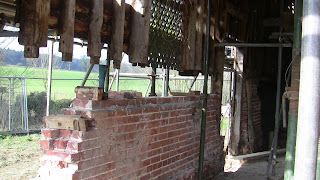Seems to me there's a fundamental difference between a repair and a new installations. Putting in something that wasn't there already, such as a length of drainpipe in the ground, is intrinsically more creative & exciting than repairing the frame or underpinning the foundation. Don't get me wrong, those things are necessary and I'm really really pleased with progress. Seeing the new timbers in place, and the re-built sections of wall gives me great pleasure. But what really gives me a buzz is a trench being dug for a drain. How sad is that, eh? But the point is, the repairs restore the barn to what it is - a barn. Whereas, digging drains and laying in a water supply are to do with transformation, movement, change, development - life itself. And that's exciting, no?
This week we've had both of those boxes ticked - repairing the old and fashioning the new.
The sole plate on the south plinth was replaced with green oak.
The concrete foundation for the replacement plinth wall on the north side was poured, or should I say barrowed.
Some timbers seem to be full of woodworm but we are assured they're sound. Of course they'll all be treated.
Traditional wooden dowels are used where possible to joint new timber to old.
And steel bracing is used where strength is crucial.
The borehole for the water supply will be surrounded by a proper manhole. The manhole chamber has a drain in case it gets flooded with rainwater. We decided to create a soakaway with an overflow to the stream, so we had to hire a bigger digger for a couple of days, in addition to the little one we've already got.
And steel bracing is used where strength is crucial.
The borehole for the water supply will be surrounded by a proper manhole. The manhole chamber has a drain in case it gets flooded with rainwater. We decided to create a soakaway with an overflow to the stream, so we had to hire a bigger digger for a couple of days, in addition to the little one we've already got.
That way they'll keep each other company and not get into mischief.
We have a few seriously large lumps of concrete on the site, a legacy from agricultural days of yore. The builder suggested we also hire a pneumatic drill attachment for the digger, known as a pecker. I was a bit reluctant to ring up the hire company and ask for a 3 ton digger with a pecker but the guy on the phone didn't bat an eyelid. At least I couldn't hear any eyelids being batted at the other end of the line when I placed my order, and the right machine and attachments turned up the next day on the back of a low loader. So my builder wasn't having me on - you never know. He hasn't asked me to hire in a set of sky hooks or purchase any pots of striped paint ... yet.
One down, one to go.
Up on the scaffold we finished drilling the roof tiles - more than 4000. What little job is the builder going to find us next?
I had a dental appointment this week. You know how it is. You lie there with the dentist's arm half way down your throat, a piercing noise about an inch from your ear, and you attempt to think nice pleasant thoughts to take you mind off what's happening inside your mouth. Well, I tried that and thought of the barn, of course. And the first thing that popped into my head was the digger with its pecker hammering into great lumps of concrete. Oops. Try to think of something else. Me up on the scaffold. Yes, that's much better - lovely views of the countryside. Very nice and peaceful. And what's that in my hand? A Black & Decker which I'm using to drill holes in tiles. Oh no. Try to think of something else. Ah yes. One of the guys on site working away. And what's he doing? Swinging a pickaxe, digging foundations. Gulp. Try to think of something else, quick. Another guy - he's got a power saw trimming a piece of timber. Oh my God. Quick. The carpenter. With a hammer and chisel cutting out a mortice and tenon on a piece of oak. Oh I give up.
but this poor fellow has lost an arm.
Building work seems to generate heaps (literally) of unwanted stuff. I was going to say soil, but much of is actually hogging, but you knew that already, didn't you. As far as I can see, hogging is soil with no loam in it. It's biologically inert. Lifeless. It's really useful stuff, when you need it. Blinding for example - to provide a smooth surface over a layer of hardcore. If what you've got is a mixture of soil, top soil, hogging, bits of concrete, broken bricks, it's known as muck. And the process of removing it is called Muckaway. Like so many things on a building site, it's not cheap. When you book a 15 ton lorry thinking that should be enough to clear it, you'll be amazed at how much of the muck is still there when he drives off.
And finally,





































